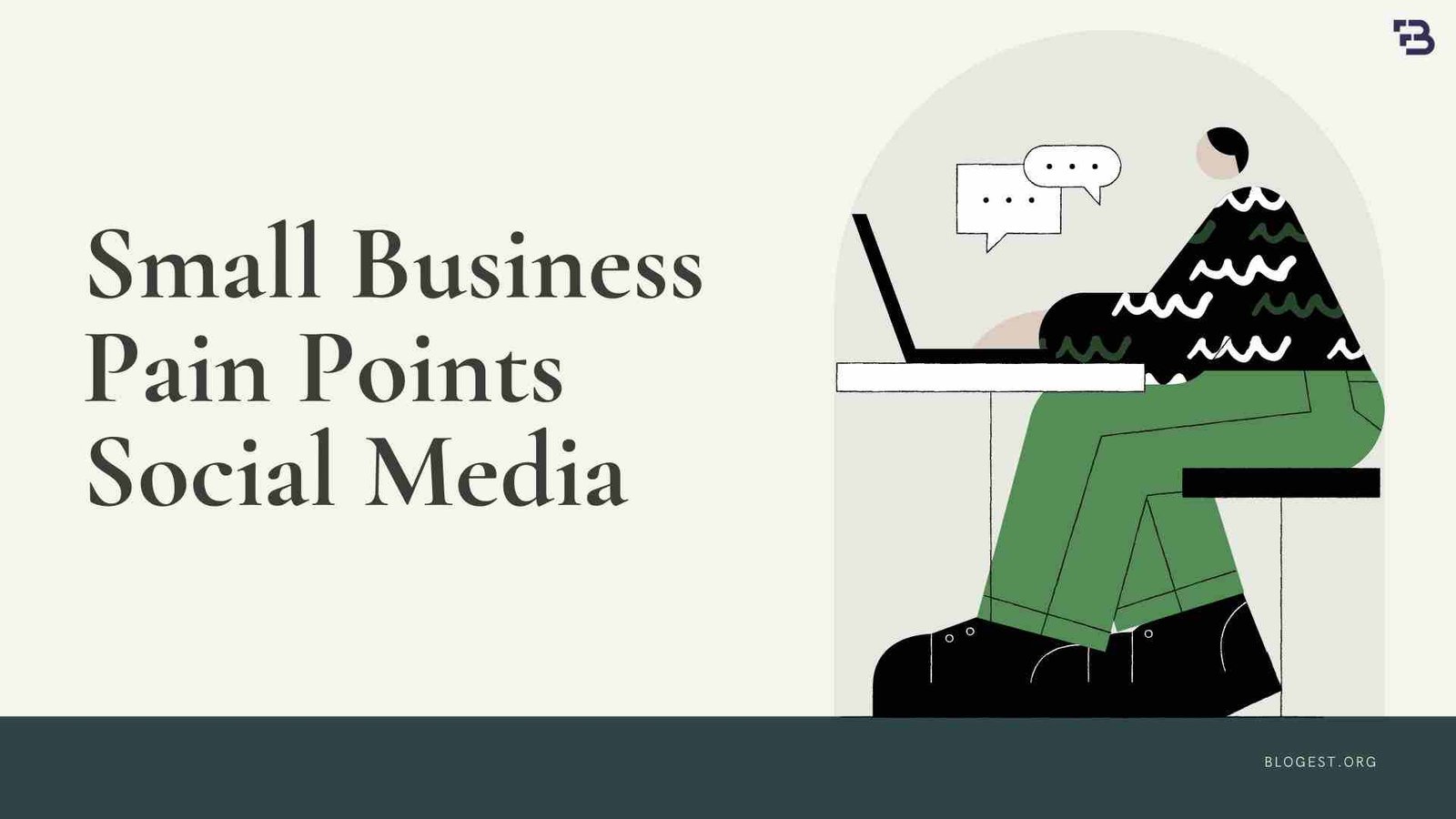Curious about small business pain points in social media?
You are in the right place(that is you are at the right spot)
The present moment involves dozens of people out of half of the world population ready to share their preferences, dislikes, interests, and reviews with others through social media platforms. Many businesses, of different shapes and sizes, benefited from this huge amounts of information that helps them understand their target audiences.
As an entrepreneur, social media becomes a vehicle of both opportunities and challenges that one has to successfully navigate in this huge virtual space.
Knowing which customer needs they want to fulfil and how to challenge big fish in the industry would be a great challenge.
Let’s explore through this post the 10 giant obstacles small businesses often face on social media and find smart compromise solutions to tackle them and keep a competitive edge in the digital era.
Explore The Top 10 Small Business Pain Points in Social Media in 2024
1. Time Management:
One of the biggest issues small business owners face is time management.
There are a million and one things to do, and social media may not even come in the top 10.
Creating quality content is an industry in itself, and requires daily updating, and management.
So, when starting your own business, managing social media posts can be difficult.
One of the biggest factors that brands and influencers both know, is that volume is important.
The more blogs and articles you have out there, the better the odds of gaining visibility.
Ideally, need to be posting several times a day.
You could use automated tools for time management like Loomly, Agroapulse, and Hootsuite to help manage content scheduling and organizing your social media platforms.
But, it is a full-time job.
So, unless you have time on your hands, take a look at hiring a digital marketing agency to help you, if you have the budget.
2. Know Your Target Audience:
You may think the most important aspect of social media is to simply share your business features and benefits online.
But, if you do not distribute this information to connect with your audience, then you are wasting your time.
So, before you post anything on social media, ask yourself these 3 questions:
- Does my content have any originality?
- Is it relevant?
- Does it add any value?
Once you know that your write-ups meet these criteria, you can post them on your social media channels.
But, do not think that your posts will go viral as soon as you send them out. It takes time and careful testing.
Audience research addresses this small business pain points on social media.
By creating content that is more relevant to your target audience, you can create better connections. Also, it helps identify other business opportunities.
3. Engaging with your Audience:
To connect with your audience and leave an impression in their minds, you need to make sure that they are heard.
Look at what they want or need, and find out what other products are lacking.
Add creatives that showcase how your products can help solve their problems.
Adding incentives is a great way to get your target audience to interact with you.
Contests or giveaways are great ways to help you boost your followers.
But interacting with your audience does not mean being available 24*7.
Just be sure that you keep your content positive and engaging so that users know that you value their opinions.
Additionally, posting videos and images is a great way to connect with your audience.
64% of consumers state that viewing a marketing video influenced their buying decisions.
So, adding video content to your social media strategy is a great way to increase engagement.
4. Having A Positive Reputation:
Before Social Media, a brand’s reputation was based solely on word-of-mouth reviews.
But now, this role is taken over by social media platforms.
One of the best options to maintain a positive reputation is to use your customer feedback to improve the overall experience.
When you do get negative feedback, turn it to your advantage and improve your business.
In case you do get negative reviews, do not ignore them.
Apologize to your customer and request them to give you another chance.
Do not argue with them but again, do not admit that it is entirely your fault.
Accept the mistake, try to make amends, and then move on.
5. Get More Social Shares:
A trouble that even small start-ups encounter is the difficulty of increasing social media shares as social media penetration grows.
This is the single best strategy (or one of the most effective avenues) to gain organic traffic but it is also a dusty, slow process.
Engage the users to share your content with their family and friends via creation of certain content.
Exploring which kinds of content inspire your audience the most, finding out what the competition is doing, discovering latest trends and identifying the ways that they can connect with your business.
The second effective way to attain this is by awarding them for social media shares.
Unlocking offers or special discounts is a great way to encourage your customers to share your social media posts.
This way you get more shares and more business exposure but are not paying for ads.
6. Curating Content:
As commented earlier, if you want people to interact with your social media platforms, then you need to post consistently.
However, one has to select and put out all returned tweets that are worth your while to ensuring that you maintain the output quality.
With regard to tools, you have the option of choosing from among ones like Answer the Public, BuzzSumo, Quora and Reddit.
It may me a good idea to monitor your competitor’s post to get some ideas from them.
It is very important to jump on the trends as soon as possible if you do not want it to be extremely late leading to your product aging.
Actually, the process of registration may give you the feeling being time-consuming.
However, keeping track of trends will help you slowly start predicting your audience’s moves and will help you stay ahead of the game.
7. Limited Funding:
Another major small business pain point – social media is funding.
For small businesses, when it comes down to buying raw materials or investing in social media, raw materials will always win.
While it may seem like an added expense to create content and post just to get a few shares and likes, exposure on social media channels is the most effective way to gain new customers.
If you are locked by funds, pick only one channel that your target audiences use, and go all in.
But, for this, you need to know where your target audience is.
If your products are for Millennials and Boomers, it will be better to focus on Facebook and LinkedIn.
Whereas if you are targeting Gen Z, Instagram, Pinterest, and Twitter are your best options.
Also, the type of industry your business falls into also matters, if you are a restaurant, then Instagram and Facebook are for you, but if you own an accounting firm, LinkedIn is a better platform to choose.
8. Multiple Platform Presence:
Facebook or Instagram are not the only social media channels that businesses use.
There are hundreds of target audiences that can be found on other social media channels like LinkedIn, Twitter, Instagram, and even TikTok.
But, you need to see where your perfect audience is.
While it is important to identify and explore opportunities on multiple platforms, you do not need to cover them all.
Check data to see which platforms are the most effective and consider where your target audience is.
9. Social Media ROI:
Just like other business aspects, your social media strategy has to have clear goals to succeed.
But assigning a numerical value to these goals like ‘increasing social media followers or ‘improving brand awareness can be tough.
Still, you need to add numbers to see how well your business is doing on social media.
Set clearly defined and attainable goals so that you can assess how well you are doing.
Remember the SMART Goals concept – Specific, Measurable, Achievable, Relevant, and Time-Bound.
While you may think that investing in social media is not required when you do not know your ROI.
But, even if you do not get monetary gains, it is still valuable.
You need to decide what metrics to track so that you know you are reaching your goals.
If you find all the data intimidating, then connect with a digital marketing agency, or watch some digital marketing videos to know more.
10. Effective KPI Development:
You know your social media marketing goals, but unless you track your KPIs, you won’t know whether they have been achieved or not.
This is another small business pain point – social media
KPIs or Key Performance Indicators help measure goal success.
For social media, you can track KPIs like the number of followers or shares, or track how many users come to your website.
Measuring the best KPIs helps you understand whether your efforts are in the right direction.
Conclusion
Social media is intimidating for small businesses, but using it properly can make a world of difference in your overall marketing plans.
Even if you start small, every exposure can help spread your business ideals and goals to newer audiences.
Rather than looking at them, as small business pain points on social media, look at them as new concepts to study to help make your business a success.





21 thoughts on “Top 10 Small Business Pain Points Social Media”